Effective logo design, part 1: symbols, metaphors and intuition capabilities
No designer can create amazing works all the time. Creating a good design requires considerable effort, but sometimes an amazing result can be achieved without straining at all. Many designers follow intuition during the creative process, and include generally accepted symbols and metaphors in their work simply because they "feel" their relevance. Intuition can be used by anyone, and it is especially useful in creative activity. It leads designers to solutions that are consistent with generally accepted knowledge.
There are three reactions to the design: yes, no, and CSO! To "wow" and need to strive.
- Milton Glazer
')
A good logo opens up great advertising opportunities. That is what they are trying to achieve. Of course, in design, intelligence plays an important role, but combining intuition, symbols and metaphors with strategic thinking you collect information that is necessary to create an outstanding and memorable logo.
Intuition is unconscious perception.
- Carl Jung
There are always people sweeping aside what cannot be measured. But many thinkers paid tribute to intuition. Albert Einstein, Richard Buckminster Fuller, Carl Jung, Ray Bredbury, Steve Jobs, and even Alan Turing, the famous logician and cryptoanalyst, understood that mathematical proofs are based on "intuition and genius." Great thinkers and futurists assign intuition a key role in the process of solving problems. For designers, intuition is not something alien, it is more like breathing. In intuition, as in water, many creators float, while their intellect dictates the formula for the execution and design of the final product.
Although formal school education teaches us to rely only on intelligence, the right balance of it with intuition will allow you to create logos that will respond to a much larger number of people. In the modern connected world this is very important.

On the one hand, modern technologies help any business to go international. On the other hand, they generate a strong background noise, which constantly has to be filtered. And the modern rigid economy demands to use smaller budgets and more clever decisions. In my experience, adding sensuality to the logo, the integration of feelings and thoughts, allows you to instantly create a person's intuitive connection with him. This allows you to not spend a lot of money on the promotion of the logo. Involving a person’s subconsciousness in a process, symbols and metaphors make it possible to hold the attention of the audience longer, which subsequently makes it easier for people to remember the logo.
Symbols appeared long before languages. Symbols and metaphors give information meaning, but each is different. Communication with symbols is compressed, fast, and metaphors link certain design elements to more accurately define it.
Describing a symbol with words is the same as catching a star with a jug, but I will try. Symbols are complete entities, whereas words are composed of letters. Symbols are processed intuitively and instantly, and the word needs to be understood, to know the language, and then converted into a visual form.

Symbols are understood immediately, and the words must first be associated with images.
Symbols refer to patterns and images common to all people. A symbol is a seed, or an egg, which grows into meaning with the participation of the observer, just as seeds and eggs grow into organisms, receiving nutrients. And although the tree is not like a seed, in its interior sits the form of the former seed. All people have a navel, our generic label connecting us to the round egg from which we evolved.
Circles and spheres denote the place of origin: molecules, cells, eggs, seeds and planets. Symbols are the archetypes of human intercourse. "Arche-" means the original, "-typ" - view. This term was popularized by Carl Jung. And, as the original species, archetypes are limited in quantity, but universal in meaning. Archetypal symbols are the basis of the systems we invent and the structures we build.
The soul does not think without images.
- Aristotle
Abstract archetypal symbols, such as the circle, contain knowledge from the collective unconscious (again Jung) of all people. Snakes and apples are an example of more complex symbols underlying a culture. The basis of the symbol is simple (spiral instead of snake). but it gets complicated when adding a cultural context. Different cultures have their own characteristics, so it is important to study the interpretation of the symbol you choose to make sure that it supports exactly the meaning that you want to convey.

Examples of the integration of symbols into structures and systems include the yin-yang symbol, where opposites complement each other to the whole, the base of the pyramid that shows into the unknowable and infinite universe, and the sacred number 7 included in the Statue of Liberty symbolizing abundance and involvement. The regular polygon with seven sides is the only one of the first ten geometric figures that cannot be drawn with a compass and a ruler, and this makes it stand out.
Symbols are perceived by the senses and the subconscious, and you first have to think about the words before creating a connection between them and the image or idea. Symbols remove this connection, so symbolic logos are so much more efficient than letters. In addition, symbols are universal, and words are language related. But they can be used together to expand both the meaning and the impact.

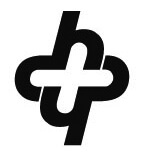
Symbolism was my main tool when in the 80s I designed a logo for a farm that grows Arabian horses. In the first sketch, I focused on the relationship between the mare and stallion, which, by touching the faces, depicted intimacy. In the second sketch, this idea developed into a relationship between a mare and a foal, which is under its protection.
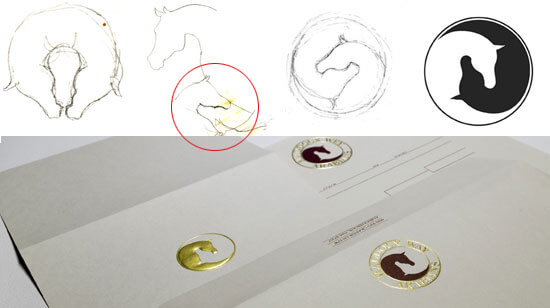
So was the process that led to the result. The symbolism condensed and simplified the logo, giving it universal significance. Visual simplicity is important for the flexibility that a logo needs to successfully apply it in different situations.
Due to the elegant structure of the bones of the Arabian horses, I was able to successfully combine the face and shoulder. The effect intensified after the conclusion of the logo in a circle, and it turned out symbolism with reference to the yin-yang.
The simplicity of the logo makes it look like a symbol that is recognizable everywhere, and which immediately enters into a personal relationship with an observer. In addition, it feels timeless and independent of the changing fashion. Symbols are ideal for long-term branding.
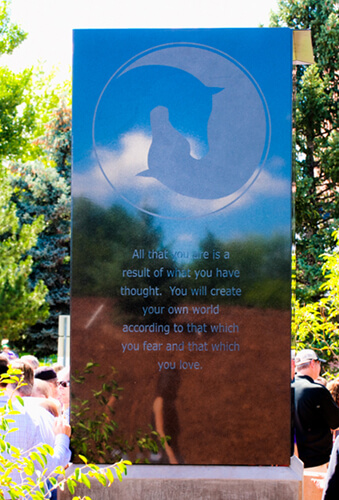
This logo was printed, extruded, used in the design of jewelry, stamps, and recently even carved into granite.
Metaphors, like symbols, are able to expand information, but they, moreover, connect together unrelated concepts. This ability to combine unexpected things allows you to identify customer features and adds interest to the development process. They are remembered because they contain the effect of "aha!".
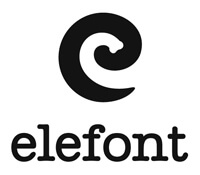
In this example, all the possibilities are used to create a simple but powerful logo that attracts attention at different levels: symbolic, metaphorical and semantic.
Valle Encantado is a partnership of farmers and artisans in Albuquerque, New Mexico. There were many opportunities to create metaphoric connections between the name and the purpose of the company. The main idea was to use the form of the letter V as a reinforcement of the name, and as a reference to farming. By activating empty and filled spaces, we maximize the message conveyed by the logo.
Also V means the top five in the Roman notation - such happy coincidences strengthen the possibilities of information transfer. As a result, the logo was further enhanced by the slogan “Cultivating Community” (Cultivating Community).
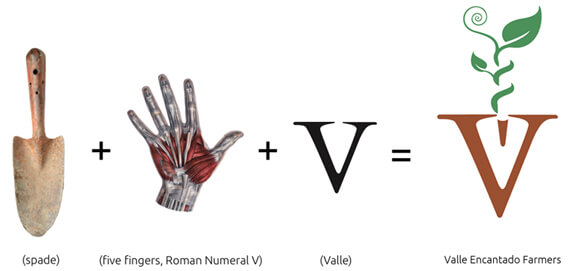
Metaphorical logos are difficult to create, but if you immerse yourself in goals, customer name, and the ability to visually link them together and expand, then several aspects can be linked into one well-packed concept. I have been creating recognizable logos in this way for 30 years, and logos that were developed decades ago continue to bring new customers (and many of them successfully stole, and therefore there were court cases - it is also important to protect my work). Logos that convey information simply and deeply benefit everyone: customers, the audience and the designer.
Symbols and metaphors help establish a connection between the client and the logo, and the logo and audience. If you use words, add them with a visual component. Secondly, consider color, style and typography. This may need to be updated over time, but if in fact the logo is symbolic, small updates will not spoil the brand. Symbols retain a brand when styles and trends change.
I often turned to early sketches during the development process and found something I hadn’t seen before. Sometimes great thoughts can be used to create a more complex or complete option. Concepts designed for one client can play for others. Respect your work and keep it. Practice being a conduit between the past and the future to maximize your creativity.
If the logo plays in two colors, it will work in any situation - from color solutions to engraving. The easier you define the meaning of the logo and the connection between the negative and the positive, the more clearly the symbolism of your concept will be defined. If possible, optimize the transfer of logo information using empty spaces as well as filled ones.
Create a logo in vectors to scale without problems. They must be ready for any scale - from mobile sites to giant billboards. If it does not work in a small size, remove the excess. If something is lost, make sure that it is not critical to convey meaning. If it looks coarse in large size, see how you can change it.
Turn it upside down, make a mirror image or turn. Ideally, it should look balanced anyway. Such a process reveals imperfections that are not visible in its usual position.
The job of a designer is to find solutions that no one can find. Work on the instincts to work with subtle things at all levels: visual, symbolic, metaphorical, wordplay, intuition. This will help you the following exercises.
Tasks are not problems, but opportunities to develop your creativity and problem solving skills. This exercise will help you understand how you process the information to issue a solution. The most important thing is to pay attention to how your internal resources relate to external ones.
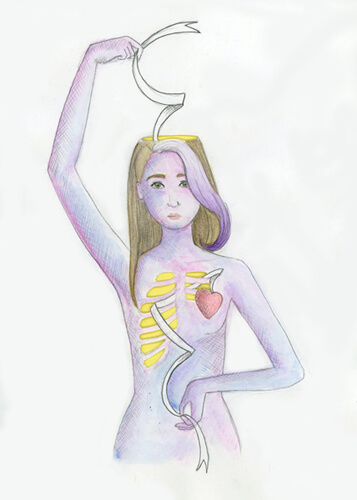
This drawing of a student shows her difficulty in tying the head and heart in the design process. The crown of the head and chest are cut off, and the tape is passed through - this is how the voluminous work is created, reinforcing its desire to combine the subconscious aspect of creativity with the practitioners of developing solutions for the real world.
Logo design is a difficult task, but it brings satisfaction. Good logos are smart, but not indulgent. They are simple, but deep enough to be interesting. They are clear and intuitive, but well remembered. And they are relevant and timeless.
Designing a good logo is the pinnacle of creative tasks. The process makes you find short images for relationships between entities. Developing practice improves your skills in working with intuition and recognizing unobvious, but effective solutions, and teaches you to find connections that are not on the surface. These are the basic principles of solving any problems, and not only the development of logos, and these methods can be applied to solve personal problems. As the British sculptor, photographer and artist Andy Goldsworthy says, "All things inside contain the energy of their creation." And, as I tell my students, learn to create a good logo, and you will learn how to create a good life.
Part 2
There are three reactions to the design: yes, no, and CSO! To "wow" and need to strive.
- Milton Glazer
')
A good logo opens up great advertising opportunities. That is what they are trying to achieve. Of course, in design, intelligence plays an important role, but combining intuition, symbols and metaphors with strategic thinking you collect information that is necessary to create an outstanding and memorable logo.
Intuitive design process
Intuition is unconscious perception.
- Carl Jung
There are always people sweeping aside what cannot be measured. But many thinkers paid tribute to intuition. Albert Einstein, Richard Buckminster Fuller, Carl Jung, Ray Bredbury, Steve Jobs, and even Alan Turing, the famous logician and cryptoanalyst, understood that mathematical proofs are based on "intuition and genius." Great thinkers and futurists assign intuition a key role in the process of solving problems. For designers, intuition is not something alien, it is more like breathing. In intuition, as in water, many creators float, while their intellect dictates the formula for the execution and design of the final product.
Although formal school education teaches us to rely only on intelligence, the right balance of it with intuition will allow you to create logos that will respond to a much larger number of people. In the modern connected world this is very important.

On the one hand, modern technologies help any business to go international. On the other hand, they generate a strong background noise, which constantly has to be filtered. And the modern rigid economy demands to use smaller budgets and more clever decisions. In my experience, adding sensuality to the logo, the integration of feelings and thoughts, allows you to instantly create a person's intuitive connection with him. This allows you to not spend a lot of money on the promotion of the logo. Involving a person’s subconsciousness in a process, symbols and metaphors make it possible to hold the attention of the audience longer, which subsequently makes it easier for people to remember the logo.
Symbols appeared long before languages. Symbols and metaphors give information meaning, but each is different. Communication with symbols is compressed, fast, and metaphors link certain design elements to more accurately define it.
Symbolic principles in logo design
Describing a symbol with words is the same as catching a star with a jug, but I will try. Symbols are complete entities, whereas words are composed of letters. Symbols are processed intuitively and instantly, and the word needs to be understood, to know the language, and then converted into a visual form.

Symbols are understood immediately, and the words must first be associated with images.
Symbols refer to patterns and images common to all people. A symbol is a seed, or an egg, which grows into meaning with the participation of the observer, just as seeds and eggs grow into organisms, receiving nutrients. And although the tree is not like a seed, in its interior sits the form of the former seed. All people have a navel, our generic label connecting us to the round egg from which we evolved.
Circles and spheres denote the place of origin: molecules, cells, eggs, seeds and planets. Symbols are the archetypes of human intercourse. "Arche-" means the original, "-typ" - view. This term was popularized by Carl Jung. And, as the original species, archetypes are limited in quantity, but universal in meaning. Archetypal symbols are the basis of the systems we invent and the structures we build.
The soul does not think without images.
- Aristotle
Abstract archetypal symbols, such as the circle, contain knowledge from the collective unconscious (again Jung) of all people. Snakes and apples are an example of more complex symbols underlying a culture. The basis of the symbol is simple (spiral instead of snake). but it gets complicated when adding a cultural context. Different cultures have their own characteristics, so it is important to study the interpretation of the symbol you choose to make sure that it supports exactly the meaning that you want to convey.

Examples of the integration of symbols into structures and systems include the yin-yang symbol, where opposites complement each other to the whole, the base of the pyramid that shows into the unknowable and infinite universe, and the sacred number 7 included in the Statue of Liberty symbolizing abundance and involvement. The regular polygon with seven sides is the only one of the first ten geometric figures that cannot be drawn with a compass and a ruler, and this makes it stand out.
Characters against letters
Symbols are perceived by the senses and the subconscious, and you first have to think about the words before creating a connection between them and the image or idea. Symbols remove this connection, so symbolic logos are so much more efficient than letters. In addition, symbols are universal, and words are language related. But they can be used together to expand both the meaning and the impact.


Using symbols in logo design
Symbolism was my main tool when in the 80s I designed a logo for a farm that grows Arabian horses. In the first sketch, I focused on the relationship between the mare and stallion, which, by touching the faces, depicted intimacy. In the second sketch, this idea developed into a relationship between a mare and a foal, which is under its protection.

So was the process that led to the result. The symbolism condensed and simplified the logo, giving it universal significance. Visual simplicity is important for the flexibility that a logo needs to successfully apply it in different situations.
Due to the elegant structure of the bones of the Arabian horses, I was able to successfully combine the face and shoulder. The effect intensified after the conclusion of the logo in a circle, and it turned out symbolism with reference to the yin-yang.
The simplicity of the logo makes it look like a symbol that is recognizable everywhere, and which immediately enters into a personal relationship with an observer. In addition, it feels timeless and independent of the changing fashion. Symbols are ideal for long-term branding.

This logo was printed, extruded, used in the design of jewelry, stamps, and recently even carved into granite.
Use of metaphors
Metaphors, like symbols, are able to expand information, but they, moreover, connect together unrelated concepts. This ability to combine unexpected things allows you to identify customer features and adds interest to the development process. They are remembered because they contain the effect of "aha!".

In this example, all the possibilities are used to create a simple but powerful logo that attracts attention at different levels: symbolic, metaphorical and semantic.
Valle Encantado is a partnership of farmers and artisans in Albuquerque, New Mexico. There were many opportunities to create metaphoric connections between the name and the purpose of the company. The main idea was to use the form of the letter V as a reinforcement of the name, and as a reference to farming. By activating empty and filled spaces, we maximize the message conveyed by the logo.
Also V means the top five in the Roman notation - such happy coincidences strengthen the possibilities of information transfer. As a result, the logo was further enhanced by the slogan “Cultivating Community” (Cultivating Community).

Metaphorical logos are difficult to create, but if you immerse yourself in goals, customer name, and the ability to visually link them together and expand, then several aspects can be linked into one well-packed concept. I have been creating recognizable logos in this way for 30 years, and logos that were developed decades ago continue to bring new customers (and many of them successfully stole, and therefore there were court cases - it is also important to protect my work). Logos that convey information simply and deeply benefit everyone: customers, the audience and the designer.
Some final thoughts on creating a good logo
Use symbols and metaphors as a base to convey information.
Symbols and metaphors help establish a connection between the client and the logo, and the logo and audience. If you use words, add them with a visual component. Secondly, consider color, style and typography. This may need to be updated over time, but if in fact the logo is symbolic, small updates will not spoil the brand. Symbols retain a brand when styles and trends change.
Collect your work and check with them in the process.
I often turned to early sketches during the development process and found something I hadn’t seen before. Sometimes great thoughts can be used to create a more complex or complete option. Concepts designed for one client can play for others. Respect your work and keep it. Practice being a conduit between the past and the future to maximize your creativity.
Develop in black and white
If the logo plays in two colors, it will work in any situation - from color solutions to engraving. The easier you define the meaning of the logo and the connection between the negative and the positive, the more clearly the symbolism of your concept will be defined. If possible, optimize the transfer of logo information using empty spaces as well as filled ones.
Make sure the logo is scalable.
Create a logo in vectors to scale without problems. They must be ready for any scale - from mobile sites to giant billboards. If it does not work in a small size, remove the excess. If something is lost, make sure that it is not critical to convey meaning. If it looks coarse in large size, see how you can change it.
Balance the logo
Turn it upside down, make a mirror image or turn. Ideally, it should look balanced anyway. Such a process reveals imperfections that are not visible in its usual position.
Notice the subtleties
The job of a designer is to find solutions that no one can find. Work on the instincts to work with subtle things at all levels: visual, symbolic, metaphorical, wordplay, intuition. This will help you the following exercises.
Exercise: Intuition and Synchronic Development
Tasks are not problems, but opportunities to develop your creativity and problem solving skills. This exercise will help you understand how you process the information to issue a solution. The most important thing is to pay attention to how your internal resources relate to external ones.

This drawing of a student shows her difficulty in tying the head and heart in the design process. The crown of the head and chest are cut off, and the tape is passed through - this is how the voluminous work is created, reinforcing its desire to combine the subconscious aspect of creativity with the practitioners of developing solutions for the real world.
- Think about the design problem you're working on, or a personal problem.
- Draw a sketch that helps to present the task (it is not a question of the ability to draw). It will be abstract or realistic - it should be relevant to the problem that is important to you.
- Tell yourself that you need help to find a solution, or to establish a relationship with this task or project, and that you are open to all ideas that can lead to a solution.
- The next few days, pay attention to what is happening around you, what you are dreaming about, or what happens in situations where you are not busy with a meaningful solution of the problem (for example, in the shower). Appearances will appear spontaneously if you bother to notice them. In particular, notice repetitive things, even if they do not seem relevant to your task.
- If images, numbers or other entities appear in different and unrelated events, try to trace their connection with your task. Watch your emotions (they also give hints). Are you concerned? Are you comfortable? What is the relationship of the task, you and the repetitive objects or phenomena? Is there a connection between them and your past experience?
- Sometimes a problem that is not related to the task does not allow a solution to be found. It is very important to respect all that your subconscious gives you, and try to interpret how this relates to your current task.
Conclusion
Logo design is a difficult task, but it brings satisfaction. Good logos are smart, but not indulgent. They are simple, but deep enough to be interesting. They are clear and intuitive, but well remembered. And they are relevant and timeless.
Designing a good logo is the pinnacle of creative tasks. The process makes you find short images for relationships between entities. Developing practice improves your skills in working with intuition and recognizing unobvious, but effective solutions, and teaches you to find connections that are not on the surface. These are the basic principles of solving any problems, and not only the development of logos, and these methods can be applied to solve personal problems. As the British sculptor, photographer and artist Andy Goldsworthy says, "All things inside contain the energy of their creation." And, as I tell my students, learn to create a good logo, and you will learn how to create a good life.
Part 2
Source: https://habr.com/ru/post/261293/
All Articles